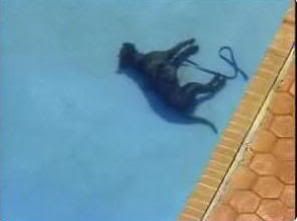

Family dog kills owner in back yard
Officers and paramedics were called to the home, where they found a "surreal scene," Coral Springs [Florida] Police Capt. Rich Nicorvo said — [Shawna] Willey dead, covered with blood, wounds on her torso, arms and legs.
The 120-pound dog was standing over her body. Nicorvo said it was "acting aggressively," and police shot and killed the animal, which fell or jumped into the pool before dying. [Palm Beach Post: August 18, 2006]
From a Palm Beach Post editorial: "[This] was a preventable tragedy that spotlights the potentially lethal trend of making family pets of fighting-type breeds. Though companionship rather than fighting may be owners' objective, the nature of the dogs cannot be ignored."
This tragedy was preventable, all right --- but what shouldn't have been ignored was the dog's poor temperament, not an imaginary "nature" shared by millions of dogs with broad heads.
Editors, this just in: the most important factors involved in preventing dog attacks are socialization, training, and informed, responsible management. Dog trainers, veterinary behaviorists and all knowledgeable owners know that patterns of negative or abnormal behavior precede most dog bites and attacks. The Pomeranian that killed a baby in Los Angeles had tried to bite other children. The Presa Canario in Florida growled at Ms. Willey so often that friends and family begged her to get rid of the dog. She told them he would "outgrow it."
He didn't.
Temperament issues exist, to some degree or another, for the life of the dog. This means that if you have a dangerously aggressive mastiff, it's imperative that you find a veterinary behaviorist or animal behaviorist to evaluate the dog and help develop strategies for dealing with its aggression. (A skilled, experienced trainer could advise you as well --- but you may not be able to determine whether a trainer is competent if you don't know much about dog behavior yourself. Board-certified behaviorists aren't everyone's first choice, but they offer the advantages of verifiable experience and a professional standard of ethics.)
Some dogs, due to irresponsible breeding, neglect, abuse or lack of training, become too dangerous for anyone to manage safely. If specialists tell you that they believe humanely euthanizing your dog is necessary to protect you, your family and members of the community from harm, then arrange for your dog to be euthanized before someone is injured or killed. Growling and snapping at people are red flags that a dog needs exceptionally responsible training and management. Banning dogs based on their appearance "will not make you safer," writes Karen Overall, "and the illusion that [breed-specific laws] will do so is dangerous to humans and unfair to dogs." Education --- furthering the general public's knowledge about dog care and dog behavior --- is the best way to protect children and adults from attacks by abused, unsocialized, badly managed dogs or dogs with unsound temperaments.
(And what do you do if you're covering the story of a woman killed by her Presa Canario? Mention pit bulls, of course: "Pit bull-like jaws." "Akin to a pit bull." (A reporter e-mailed me: "I didn't write that ['akin to a pit bull'] sentence; it was edited in after I filed the story and went home.") When experts talk about "media-driven portrayals of a specific breed as 'dangerous,'" this is what they mean.)
No comments:
Post a Comment